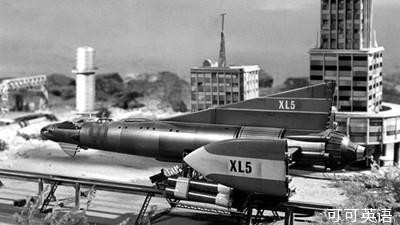科學技術
Launching aircraft
發射飛機
Proof by induction
讓電磁感應來驗證
In the future, airliners could be catapulted into the sky by electric motors
將來,會用電動機將客機彈射到天空中
READERS of a certain age may remember Fireball XL5, a children's television programme devised by Gerry Anderson about a spacecraft of that name.
某個年齡段的讀者可能還記得《雷霆機》這個兒童電視節目,這個節目是由格里安德森制作的,講的是一艘叫做雷霆機的宇宙飛船的故事。
 Instead of taking off vertically, as real spacecraft do, Fireball XL5 sat on a rocket-propelled trolley that accelerated it horizontally to launch speed.
Instead of taking off vertically, as real spacecraft do, Fireball XL5 sat on a rocket-propelled trolley that accelerated it horizontally to launch speed.
與現實中的宇宙飛船垂直起飛不同,雷霆機是架在一個由火箭推動的滑車上,水平加速到發射速度。
And that, in effect, is what engineers at Airbus, Europe's largest civil-aviation company, are proposing in their latest bout of blue-sky thinking.
實際上,這是空中客車公司的工程師們在其最近一次天馬行空的想法中提出的建議。
Apart from the fact that the trolley would be powered by linear-induction motors rather than rockets, they are suggesting that the fantasy of 1962 might become the reality of 2050.
滑車由線性感應電動機提供動力,而非火箭,除此之外,他們認為1962年的幻想會在2050年成為現實。
Mindful that many passengers are already nervous about the whole process of getting a plane airborne, the engineers prefer to call their proposal Eco-climb.
考慮到飛機離開地面的整個過程中已經夠讓許多乘客緊張了,工程師更喜歡將他們的提議稱為環保型起飛。
But the idea is straight out of Fireball.
但這一想法是直接來自于雷霆機的。
The aircraft to be launched would sit on a platform that ran along a track where the runway would otherwise be.
待發射的飛機會架在一個沿軌道滑行的平臺上,而這軌道可說是跑道的另一種形式。
The platform would accelerate to take-off speed, at which point the plane would lift into the air powered by its own engines.
平臺會加速到起飛速度,到達這一速度點后,飛機便可以通過自己的引擎升上天空。
Taking off in this way would both save fuel and make life more pleasant for those who live near airports.
以這種方式起飛既可以節約燃料,又能夠讓住在機場附近的人過的更舒心些。
Aircraft engines are optimised for level flight at cruising speed in the stratosphere.
飛機引擎最適合在平流層以巡航速度水平飛行。
Using them to accelerate a plane on the ground wastes a lot of fuel.
在地面上用它們為飛機加速會浪費很多燃料。
An induction-motor-powered platform, by contrast, would be optimised for the job at hand.
相比之下,由感應電動機提供動力的平臺最適合手頭的這個工作,
It could launch the plane at higher speed, letting it climb faster.
它能以更快的速度發射飛機,讓飛機爬升更快,
That would save fuel, too.
還能節約燃料,
It would also mean fewer people on the ground suffered aircraft noise.
還意味著地面上要經受飛機噪音的人更少了。
And it could do all this from a track that was a third shorter than a conventional runway.
所有這些在一條比傳統跑道短三分之一的軌道上即可完成。
Altogether, according to Airbus's back-of-the-envelope calculations, Eco-climb would reduce fuel consumption by 3% on a typical 900km flight, even with existing aircraft designs.
總而言之,很據空中客車的粗略計算,按一次典型的900公里的飛行算,即使按照現在的飛機設計,環保型起飛也能將其油耗減少3%。
But it would also allow for the design of lighter aircraft, with smaller engines, which would cut fuel consumption, noise and emissions further.
而且它還為設計引擎更小,重量更輕的飛機留下了空間,可以進一步降低油耗,噪聲及排放。
Nor is the idea complete fantasy. General Atomics, an American military contractor, has already built and tested a linear-induction-motor-based system of this sort at an airbase at Lakehurst, New Jersey.
這個想法并不完全是幻想。通用原子公司是一家美軍的承包商,其已經在一座位于新澤西州萊克赫斯特的空軍基地建造了一個這類基于線性感應電動機的系統,并進行了測試。
The General Atomics system is now being scaled up to be fitted on a new generation of aircraft carriers for the American navy.
目前通用原子正在對該系統進行放大,以便能裝備到美國海軍的新一代航空母艦上。
A launcher powered by a linear-induction motor has several advantages over the steam-driven catapults used on existing aircraft carriers, according to General Atomics.
據通用原子公司稱,與現在航空母艦上使用的蒸汽動力彈射器相比,由線性感應電動機提供動力的發射臺有多個優點。
Whereas a steam catapult lets rip with a constant force, the speed and power of a linear motor can be controlled to provide smooth acceleration.
恒定的力使蒸汽彈射器難以控制;而線性電動機的速度和力量都可以控制,可帶來平緩的加速,
That extends the life of an aircraft by subjecting it to less stress.
因為承受的壓力更小,所以能夠延長飛機的壽命,
It also makes for a more comfortable take off.
并且能讓起飛時更舒服一些。
And the launch shuttle can brake quickly once the plane has lifted off by reversing the current running through the motor.
飛機一旦起飛,通過反轉電動機中的電流,發射裝置能夠快速制動,然后返回原位準備下一次發射。
What works in a military context might not, of course, be appropriate for civil aviation—one reason why nobody has considered equipping airports with steam catapults.
當然,在軍事中使用的技術不一定適合民用航空,這也是為什么沒人會考慮在機場配備蒸汽彈射器的一個原因。
But the smooth operation of a linear motor means the take-off force could be kept within the 2.5g typically felt in a modern airliner dashing along a runway.
但是線性電動機的平緩運行意味著起飛的力會在2.5倍重力加速度之內,與一架現代的客機沿著跑道加速時的感覺一樣。
Passengers need not be subjected to Top Gun levels of acceleration.
乘客們不需要去承受《壯志凌云》那種級別的加速度。
It might be possible to use linear motors for landings, too.
將線性電動機用于著陸也是有可能的。
Carrier-style arrester wires would cause too much damage and would hardly be comfortable for passengers.
航母式的攔截索會是飛機產生很多損傷,而且乘客也不會舒服。
But if an incoming aircraft landed on a moving platform equipped with a linear motor, the current in the motor could then be reversed to slow it down.
但如果一架準備降落的飛機在一個裝有線性電動機的移動平臺上著陸,電動機中的電流會反轉,使飛機減速。
That might mean planes could do without landing gear, saving still more weight. Even Mr Anderson didn't think of that one.
這或許意味著飛機沒有起落架也行,能讓飛機再輕一些。
Fireball XL5 landed vertically, on retro-rockets.
安德森先生都沒有想到這種方法,雷霆機是靠制動火箭垂直著陸的。
 Instead of taking off vertically, as real spacecraft do, Fireball XL5 sat on a rocket-propelled trolley that accelerated it horizontally to launch speed.
Instead of taking off vertically, as real spacecraft do, Fireball XL5 sat on a rocket-propelled trolley that accelerated it horizontally to launch speed.
 Instead of taking off vertically, as real spacecraft do, Fireball XL5 sat on a rocket-propelled trolley that accelerated it horizontally to launch speed.
Instead of taking off vertically, as real spacecraft do, Fireball XL5 sat on a rocket-propelled trolley that accelerated it horizontally to launch speed.